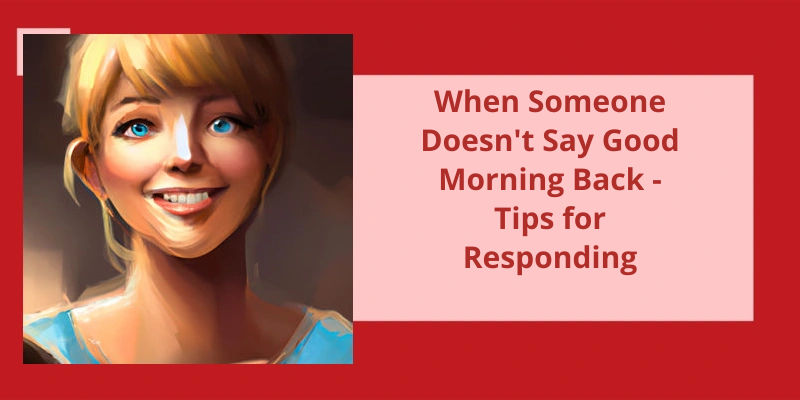When we wake up in the morning, a simple “good morning” can set the tone for the rest of the day. It's a polite and friendly gesture that acknowledges the presence of another person and shows that you care about their well-being. However, there are times when we might offer a “good morning” to someone, only to be met with silence or indifference. This can be frustrating and sometimes hurtful, as it can feel like our effort to be friendly is being disregarded. It’s important to remember that responding to a “good morning” doesn't necessarily mean one has to repeat the phrase verbatim, but a simple acknowledgement is a basic human interaction that isn’t only courteous but also helps to build social relationships. Not responding at all, or worse, responding negatively, can be perceived as rude and may make the other person feel unwelcome or uncomfortable. So, whether it's a “good morning,” “hello,” or some variation thereof, taking a moment to acknowledge someone's greeting is a small but significant way to show that you value their presence in your life.
Is Not Saying Good Morning Disrespectful?
For some, not saying good morning may be seen as disrespectful or rude. It can come across as ignoring or snubbing the person who’s attempting to greet you. In most cultures, it’s customary to greet someone when you see them, and not doing so can be seen as a breach of social manners. In many cases, it can be seen as a lack of politeness or manners, and may raise questions about ones character.
At the same time, there are a lot of factors to consider when it comes to social interaction. Some people may be more introverted or may not feel comfortable engaging in small talk with people they don’t know very well. For them, it may be difficult to engage in a greeting, especially if they aren’t expecting it. Similarly, some people may be preoccupied or lost in thought, and may not even notice that someone is attempting to greet them.
It’s important to be aware of the social norms and expectations in your community, but also to be respectful of other peoples boundaries and preferences. Ultimately, a bit of kindness and consideration can go a long way in building positive relationships and fostering a sense of community.
The Origins and History of Greeting Customs in Different Cultures
Greeting customs have developed and evolved differently across cultures throughout history. These customs can be influenced by factors such as religion, social status, and geography. It’s important to be aware and respectful of these customs when interacting with individuals from different cultures.
Now that we’ve established the proper response to a “good morning” greeting, it’s worth noting that communication norms can vary depending on the context. In the professional world, using the word “morning” as a response can demonstrate a level of formality and professionalism. But is this always the case? Let’s explore further.
Can You Reply Morning to Good Morning?
The use of the word “morning” as a reply to “good morning” has become a common practice in business settings. It’s often seen as a more efficient and professional way to greet someone, as it eliminates the need for a full repetition of the phrase “good morning.”. This type of response can also be viewed as a non-committal way of acknowledging the greeting without getting too personal.
The most important aspect is that the response is respectful and acknowledges the persons greeting. For example, some individuals may prefer to respond with a smile and a nod or a verbal greeting like, “Hello, how are you doing?”. While others may opt for a simple wave or a quick “hey.”
Regardless of the response, it’s always important to be polite and maintain a positive attitude. A simple gesture or greeting can go a long way in building and maintaining relationships.
It’s also worth noting that in some cultures, the use of certain words or phrases can have a significant impact on how people are perceived. For example, in some Asian countries, it’s common to use honorifics when addressing someone of higher rank or status. Similarly, in some Latin American cultures, it’s customary to use “usted” instead of “tu” when addressing someone in a more formal setting.
As with any communication, it’s important to consider cultural nuances and use appropriate language to ensure that your message is received positively.
The History and Origins of the Phrase “Good Morning”
- The phrase “good morning” originates from Middle English, which was spoken from the 11th to 15th centuries.
- The phrase was originally used to express good wishes for a good day ahead.
- Over time, “good morning” became a standard greeting used when meeting someone in the morning.
- Today, “good morning” is used as a polite way to acknowledge someone when you see them in the morning.
- The phrase is used in English-speaking countries around the world, although different languages may have their own unique morning greeting customs.
Source: What should we say when someone wishing us good morning?
Aside from personal interactions, saying “good morning” is also a common greeting used in text messages. But have you ever wondered why people still say this in their digital communications? In this article, we will explore the reasons behind this practice and the significance of these simple words in our everyday lives.
Why Do People Say Good Morning in Text?
It’s a form of social etiquette that’s been passed down through generations. People say good morning as a polite greeting to start the conversation in a positive and friendly manner. It’s a way to connect and show respect for the other person.
In todays fast-paced world, where we’re always rushing, saying good morning can make a significant difference in someones day. It shows that we care and that we value the other persons presence in our lives. It can make someone feel appreciated and can help build strong and positive relationships.
Saying good morning in a text message is a convenient way to keep in touch with friends, family, and colleagues. It’s a way to let them know that you’re thinking about them and wishing them well. In a world where we’re increasingly reliant on technology, saying good morning in a text message can help bridge the gap between the virtual and the physical worlds.
They argue that in todays world, where we’re always connected, we don’t need to rely on these traditional greetings as much.
Which Is Correct Goodmorning or Good Morning?
While the difference between goodmorning and good morning may seem negligible to some, it’s still important to ensure that you’re using the correct spelling in your communication. Using the incorrect spelling may not only appear unprofessional but may also convey a lack of attention to detail.
One potential reason why goodmorning has become a popular spelling is due to the prevalence of text messaging and social media. In these forms of communication, there’s an emphasis on brevity and efficiency, often leading to the convergence of words and elimination of spaces. However, it’s important to remember that these platforms may not necessarily reflect proper spelling and grammar usage.
Furthermore, the spelling of good morning may also vary across different languages and cultures. Depending on the language, there may be different rules regarding the use of spaces and capitalization. Therefore, it’s important to be mindful of the appropriate spelling conventions when communicating with individuals from different backgrounds.
Taking the time to ensure that you’re using the correct spelling may not only demonstrate attention to detail but also a level of professionalism in your communication.
While it may seem like a small detail, it can have a big impact on how you’re perceived by others in both personal and professional settings. By taking the time to be mindful of proper spelling conventions, you can demonstrate a level of professionalism and attention to detail that will set you apart from others.
Etiquette for Greeting People in Different Cultures and Languages.
- Shake hands firmly with eye contact – United States
- Bow slightly with hands at your sides – Japan
- Avoid physical touch – Middle East
- Use “namaste” with hands pressed together – India
- Kiss on the cheek – France
- Avoid showing the soles of your feet – Thailand
- Use a slight nod with a smile – China
- Use “hola” with a kiss on the cheek – Spain
- Use “salaam” with a slight bow – Middle East
- Use “ciao” with a kiss on both cheeks – Italy
Social etiquette in the workplace can have a significant impact on workplace culture and relationships among colleagues. One such area where employees often struggle is in the simple act of acknowledging each other with a simple greeting like “good morning.” While some may view it as an inconvenience, overlooking this social nicety can lead to difficulties down the line. In this article, we’ll explore whether or not it’s disrespectful to skip the morning greeting and why it matters.
Is It Disrespectful to Not Say Good Morning?
Starting the day by saying “good morning” is one of the simplest pleasantries to exchange with our co-workers. It’s a small gesture that can go a long way in improving social dynamics in the workplace. Failing to acknowledge your colleagues when you walk into work isn’t only a missed opportunity to build relationships, but it could also come across as rude and disrespectful. People notice when others don’t make an effort to say hello, and it can lead to feelings of negativity and isolation.
It shows that you respect and value your co-workers as individuals, regardless of their position or seniority. By acknowledging each other, you create a positive atmosphere where people feel comfortable interacting with one another, and this can lead to stronger team cohesion and improved performance in the long run.
Furthermore, exchanging greetings each morning can be helpful in setting the tone for the rest of the day. When you start your day by acknowledging your colleagues, it sets a positive tone that can carry over into your work. It creates a sense of unity and shared purpose that can motivate individuals to work together towards achieving a common goal.
The Impact of Body Language and Tone of Voice in Greeting Others
- Body language can convey confidence, warmth, and interest in greeting others.
- Standing up straight, making eye contact, and offering a firm handshake can make a positive first impression.
- Facial expressions such as smiling and nodding your head can help to establish rapport with the other person.
- Tone of voice can also impact how others perceive us in a greeting.
- Speaking clearly, with a friendly tone and appropriate volume, can help to establish trust and make the other person feel comfortable.
- On the other hand, a monotone or aggressive tone can put others on edge and make them less receptive to your message.
- It’s important to be mindful of your body language and tone of voice when greeting others, as they can greatly impact the success of the interaction.
Knowing the proper way to greet someone can make all the difference in how your communication is received. When it comes to morning greetings, there are a few rules to follow depending on the time of day. Let’s take a closer look at the different ways to say good morning and when to use them.
What Is the Rule for Good Morning Wish?
When it comes to wishing someone a good morning, there are a few more things to consider besides just the time of day. It’s important to think about the context and the relationship you’ve with the person you’re addressing. If you’re in a formal or professional setting, you might choose to say “Good morning” followed by the person’s title and last name. For example, “Good morning, Dr. Smith.”
If you’re close friends or family members, you might even add a little personal touch to your greeting, such as “Good morning, sleepyhead!” or “Good morning, sunshine!”
Regardless of the context, it’s important to remember to approach your greeting with sincerity and positivity. A good morning wish is meant to set a positive tone for the rest of the day, so make sure your message reflects that. You might follow up your greeting with a compliment, such as “You look great today” or “I hope you’ve a fantastic day.”
It’s also important to be aware of cultural differences and customs when it comes to morning greetings. In some cultures, it’s customary to bow or show a sign of respect when greeting someone in the morning, while in others, a simple nod or wave is sufficient. If you’re unsure about how to appropriately greet someone, it’s always a good idea to do a little bit of research or ask a cultural expert.
With a little bit of thought and care, your morning greeting can be a great way to start someone’s day off on the right foot.
How to Respond to a Good Morning Wish
- Respond with a simple “Good morning” or “Morning” back.
- If you want to sound more enthusiastic, reply with “Good morning! How are you?”
- You could also add a smiley or emoticon to your response to convey friendliness.
- Remember to match the tone of the person who greeted you. If they were very cheerful, respond in kind!
- If you’re not a morning person and don’t feel like talking, a simple nod or wave could suffice.
Conclusion
In conclusion, social interactions and courtesy play a vital role in our daily lives, and small actions like exchanging greetings can have a significant impact on our relationships with others. When someone fails to acknowledge a simple greeting like "good morning," it sends a message of disrespect and can make the other person feel ignored or unimportant. While there may be valid reasons for not responding, it’s essential to remember the importance of acknowledging others in social situations. Whether through a simple gesture or a brief conversation, it’s crucial to show respect and kindness towards those around us. Ultimately, our words and actions can make a difference in the lives of others, and it’s up to us to choose how we want to interact with the world.






